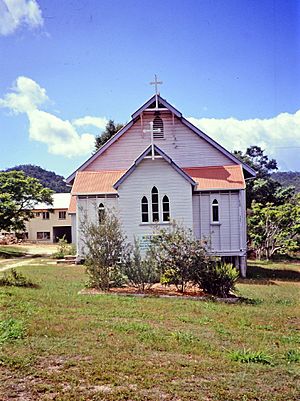Holy Trinity Anglican Church, Herberton facts for kids
Quick facts for kids Holy Trinity Anglican Church, Herberton |
|
|---|---|

Holy Trinity Anglican Church, 1992
|
|
| Location | 38 Broadway Street, Herberton, Tablelands Region, Queensland, Australia |
| Design period | 1870s–1890s (late 19th century) |
| Built | 1889 |
| Architect | Eyre & Munro |
| Official name: Holy Trinity Anglican Church, Holy Trinity Church of England | |
| Type | state heritage (built) |
| Designated | 21 October 1992 |
| Reference no. | 600538 |
| Significant period | 1889, 1907 (fabric) 1902–1935 (historical) |
| Significant components | memorial – chamber/room, furniture/fittings |
| Builders | H Petersen |
| Lua error in Module:Location_map at line 420: attempt to index field 'wikibase' (a nil value). | |
The Holy Trinity Anglican Church is a historic church located in Herberton, a town in the Tablelands Region of Queensland, Australia. It was built in 1889 and is also known as Holy Trinity Church of England. This church is considered very important, so it was added to the Queensland Heritage Register in 1992.
Contents
History of the Church
Building the Church
The Holy Trinity Church was built in 1889. It was made for the Anglican community in Herberton. At that time, Herberton was a fast-growing mining town.
Herberton became a busy place after tin was discovered nearby in 1880. Many people rushed to the area. By August 1880, Herberton already had a hotel, a butcher's shop, and three stores. The tin fields around Herberton were some of the richest ever found in Australia.
The first Anglican priest in Herberton was Reverend G. White. He arrived in 1887. Church services were held in Herberton and other nearby towns. In 1888, plans for a new church were drawn up. The architects were Eyre and Munro from Townsville. H Petersen was the builder. The church was finished and opened on June 30, 1889. It was a simple rectangular building with a small entrance porch.
The Brotherhood of St Barnabas
By 1898, the Herberton church served many towns. These included Herberton, Atherton, and Irvinebank. The area was large and isolated, with poor roads. This made it hard for priests to visit everyone.
To help with this, the Brotherhood of St Barnabas was started in 1902. It was founded by Aneurin Vaughan Williams, who was the priest in Herberton. The Brotherhood was a group of priests who traveled to different communities. They helped people in remote areas. Herberton became their main base.
Church Improvements and Special Features
Over the years, the church was improved. In 1907, a vestry (a room for the priest to prepare) was added. In 1919, a new porch was built, and electric lights were put in.
In the 1920s, the church received beautiful new pieces. These included a baptismal font, an altar, and a chair and table for the sanctuary. These items had amazing carvings done by Miss Amelia Grace Eckley Philpott. She later became a nun known as Sister Rosa. After she passed away in 1928, a special Children's Corner chapel was created in her memory in 1929.
The Brotherhood of St Barnabas stopped looking after the Herberton church around 1935. Today, the main church for the area is in Atherton. The priest from Atherton also serves Herberton and other small towns. In 1989, the Holy Trinity Church was renovated to celebrate its 100th birthday.
What the Church Looks Like
Outside the Church
The Holy Trinity Church is a single-story building made of timber. It has a gabled roof covered with corrugated iron. A small part of the roof sticks out at the front. Underneath it, a bell hangs. The front walls of the church are covered with special timber called chamferboard.
There is a separate vestry at the back corner of the church. It has an arched doorway. The church has tall, narrow windows called lancet windows. There are three of these windows together on the front wall.
Inside the Church
Inside, the church has a large central area called the nave. The roof inside is lined with timber. The walls are also lined with horizontal timber boards. A pointed arch separates the main area from the raised sanctuary at the front.
The church still has its original pews (church benches). The baptismal font, altar, and the chair and table in the sanctuary are very special. They have beautifully carved panels, which were made by Miss Philpott.
Why the Church is Important
The Holy Trinity Anglican Church was added to the Queensland Heritage Register in 1992. This means it is a very important historical site.
- A Look into History: The church shows how Herberton and the Anglican Church grew in Queensland. It was also the starting point for the Brotherhood of St Barnabas. This group helped bring church services to small, isolated communities.
- A Great Example of Design: The church is a good example of a timber church found in country areas. Its design and size make it a special part of Herberton's look.
- Beautiful to See: The church is considered beautiful. Its design and details add a lot to the character of Herberton.
- Important to the Community: The Holy Trinity Church has a strong connection with the Anglican community in Herberton. It also has a special link to the work of the Brotherhood of St Barnabas, who helped people across the Tablelands.

